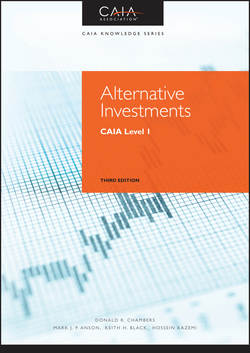Читать книгу Alternative Investments - Hossein Kazemi - Страница 31
На сайте Литреса книга снята с продажи.
PART One
Introduction to Alternative Investments
CHAPTER 2
The Environment of Alternative Investments
2.2 Financial Markets
ОглавлениеThis section provides an overview of the financial markets involved in alternative investments. A primary market refers to the methods, institutions, and mechanisms involved in the placement of new securities to investors. A secondary market facilitates trading among investors of previously existing securities.
2.2.1 Primary Capital Markets
New issues are sold in primary capital markets and distributed by an underwriter, who is responsible for the organization, risk bearing (during placement), and distribution (or sale) of newly issued securities. Investment banks serve as underwriters for the placement of traditional investments. For example, investment banks place new equity issues that originate either as new and additional shares in existing securities (secondary issues) or as first-time issues of shares not previously traded (initial public offerings, or IPOs).
In the modern global economy, firms often arrange to have their shares traded in foreign markets and denominated in the currency of the foreign market. For example, a German firm could list its stock on a U.S. exchange as an American depositary receipt (ADR) or a global depositary receipt (GDR). Foreign issuers must comply with all the rules that apply to domestic firms, as well as any additional regulations that apply to foreign issuers.
Another source of securities issued in primary capital markets is securitization. Securitization involves bundling assets, especially unlisted assets, and issuing claims on the bundled assets. The securities are registered and sold in the public market. Securitization can allow firms to divest illiquid assets such as accounts receivable to lay off risk and obtain cash. Various types of unlisted but liquid assets are also securitized, including various fixed-income securities such as mortgages. Exchange-traded funds are emerging as a major source of securitization, in which new securities are created, generally with underlying portfolios of listed securities.
Participants in alternative investments often create securities that are not subsequently listed. An example is when deal creators issue structured products, some of which are private (see Part 5). Private equity firms often use primary markets as exit strategies for their underlying investments. Large private equity firms hold substantial controlling positions in the companies. A goal of these private equity firms is to develop these companies to the point that they can be sold to the public through IPOs.
2.2.2 Secondary Capital Market
After their initial offerings, many securities are traded in secondary capital markets, which provide greater liquidity and a continuous flow of price information. In major markets, limit orders by market participants are maintained to buy securities (bid orders at bid prices) and to sell securities (offer orders at ask prices). The price difference between the highest bid price (the best bid price) and the lowest offer (the best ask price) is the bid-ask spread. Market making is a practice whereby an investment bank or another market participant deals securities by regularly offering to buy securities and sell securities. The market maker seeks to receive the bid-ask spread through regularly selling at the ask price and buying at the bid price. The bid-ask spread compensates investment banks for providing liquidity to the market. Market participants that wish to have transactions executed without delay may place market orders, which cause immediate execution at the best available price. Participants that place market orders are market takers, which buy at ask prices and sell at bid prices, generally paying the bid-ask spread for taking liquidity.
The primary listing markets in the United States are the New York Stock Exchange (NYSE) and the NASDAQ. The NYSE has physically centralized trading, while the NASDAQ uses computer networks between dealers. The largest markets outside the United States include the Tokyo Stock Exchange (Japan), the Euronext (several locations), the London Stock Exchange (United Kingdom), and the Hong Kong Stock Exchange (China).
2.2.3 Third and Fourth Private Markets
Third markets are regional exchanges where stocks listed in primary secondary markets can also be traded. In the United States, third markets allow brokers and dealers to set up trades away from an exchange by listing their prices on the NASDAQ Intermarket. Third markets represent a segment of the OTC market where nonmember investment firms can make markets in and trade securities without going through the exchange.
Fourth markets are electronic exchanges that allow traders to quickly buy and sell exchange-listed stocks via the electronic communications systems offered by these markets. Because of the anonymity of traders within these electronic networks, registered broker-dealers provide sponsorship for these systems so that traders have an alternative system to physical exchanges to buy and sell stocks. These alternative trading systems are computerized trading systems that do not formally list stocks but include electronic communication networks serving retail brokers and small institutional traders, as well as electronic crossing systems that match large buy and sell orders. This system is also called the fourth market system. These private financial markets are non-regulated markets that are neither exchanges nor OTC.
Much of the high-frequency trading takes place in the fourth market. The advantages of private markets may include lower transaction costs, ease of completing a transaction directly between a buyer and a seller (which may or may not involve a broker), and the ability to expedite the consummation of a transaction. Conversely, the disadvantages may include the existence of asymmetrical information (between the participants), lack of transparency, and lack of regulatory protections.
